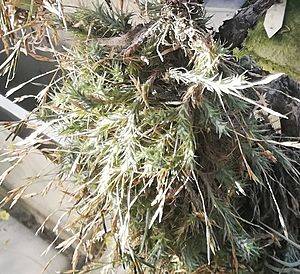Tillandsia tricholepis facts for kids
Quick facts for kids Tillandsia tricholepis |
|
|---|---|
 |
|
| Scientific classification | |
| Genus: |
Tillandsia
|
| Species: |
tricholepis
|
| Synonyms | |
|
Tillandsia bryoides Griseb. ex Baker |
|
Tillandsia tricholepis is a fascinating type of flowering plant that belongs to the Bromeliaceae family. You might know other plants from this family, like pineapples! This plant is special because it's an epiphyte. This means it grows on other plants, like trees, or even on rocks. But don't worry, it doesn't hurt them! It just uses them for support.
This unique plant is a native species to several countries in South America. You can find it growing naturally in Bolivia, Paraguay, Argentina, and Brazil.
Contents
What is Tillandsia tricholepis?
Tillandsia tricholepis is a small plant that is part of a very large group called Tillandsia. These plants are often called "air plants" because they don't need soil to grow. Instead, they get all the water and nutrients they need from the air around them. They absorb moisture from rain, fog, or dew through special scales on their leaves.
How it Grows and Lives
As an epiphyte, Tillandsia tricholepis attaches itself to tree branches or rocks. It uses its roots mainly to hold on, not to take in water or food. Its leaves are designed to collect moisture and dust from the air. This allows it to live in places where other plants might struggle, like on the sides of cliffs or high up in trees.
Its Appearance
This plant is known for its interesting look. Its name, tricholepis, comes from Greek words meaning "hair" and "scale". This might refer to the tiny, hair-like scales on its leaves. These scales, called trichomes, help the plant absorb water and protect it from too much sun.
Where You Can Find It
Tillandsia tricholepis thrives in warm and humid environments. It is found in various habitats across its native countries. These include forests, woodlands, and sometimes even rocky areas. It prefers places where there is enough moisture in the air.
Discovery of the Plant
This plant was first officially described in 1878. The person who named it was a famous botanist named John Gilbert Baker. He was an English botanist who studied many different kinds of plants. His work helped us learn more about the plant world.
See also
 In Spanish: Tillandsia tricholepis para niños
In Spanish: Tillandsia tricholepis para niños

